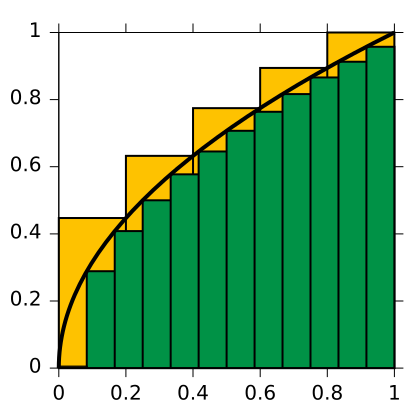Usage of dx in Integrals
Solution 1:
I think your question here shows that, while you have been using these symbols, you haven't really been given a proper motivation for where they came from.
Let's go back and consider how we came up with the idea of an integral. In a typical class, you will see a lot of pictures like this:
We find the area under the curve by summing up the area of all these little rectangles. If we wanted to write an expression for the area, it would look like:
(source: mathurl.com)
The Σ means that we are computing a sum. We are adding the areas of the rectangles, which we have numbered 1 through n, to get the complete area under the curve. The area of each rectangle is given by multiplying the height by the width. The height is given by f(xi) because the base of the rectangle is at 0, and the top of the rectangle is where it meets the function f. The Δx represents the width of each rectangle.
When we find the integral, we are taking the limit of this sum as the number of rectangles goes to infinity, and each individual rectangle becomes infinitesimally tiny. You can think of the dx as the equivalent of Δx: it represents the infinitesimally small width of each rectangle that we added up to get the area.
Once you realize this, we can see why integrals only make sense when written ∫f(x)dx. Because we are adding up the areas of rectangles that have height f(x) and width dx. If you try to interpret the expressions you wrote in this way, you will see that they do not really make sense as integrals: you are not summing up rectangles, so you are not finding an area under a curve.
You could, of course, define your own notation in which those expressions behave the way you expect them to, but all mathematical notation is driven based on what people find useful, and what people can agree on and easily understand. Your reuse of the integral sign and dx that people are used to seeing in a particular context will probably result in few people adopting your definition.
Solution 2:
When you write $\int f(x) dx$, the whole of $\int ... dx$ is an indivisible symbol, just as the $d/dx$ is an indivisible symbol when you write $df/dx$.
Of course, there are reasons why the notation is as it is, but trying to manipulate it like you suggest in $\int e^{dx}$, for example, is simply meaningless.